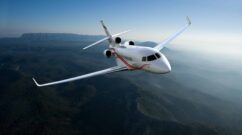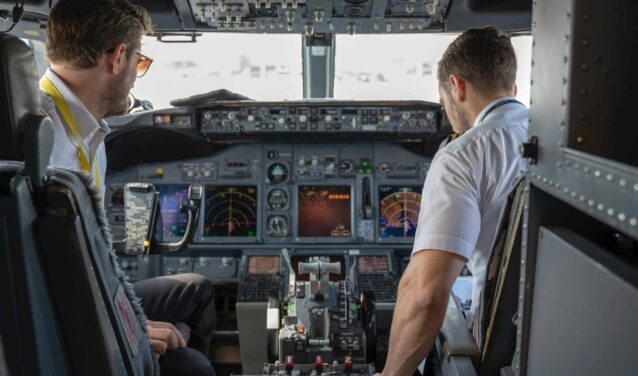The key to a successful private jet flight is a good crew. The crew members are the guarantors of a tailor-made quality of service, and they take care of the passengers on board the aircraft. The flight crew is also responsible for the smooth running of the flight and safety on board. But how many people make up a crew? What are the rules in force? AEROAFFAIRES presents the different crew members on board a private jet in detail.
The crew leader: the pilot and co-pilot
It is impossible to imagine a private jet flight without a crew chief on board! The presence of the pilot, often accompanied by a co-pilot, is essential behind the controls of the aircraft.
The role and missions of the private jet pilot.
The role of the private jet pilot is to fly the aircraft safely and in compliance with aviation regulations. Their duties include :
- Ensuring the safety of passengers and crew: The pilot’s priority is to ensure the safety of all passengers on board. To ensure a safe flight, he/she must comply with safety standards and established flight procedures.
- Plan and prepare the flight: The private jet pilot must plan the flight in advance. They must analyse the weather, flight conditions, flight time and resources required for the flight.
- Flying the aircraft: The pilot is required to fly the aircraft safely. To do so, he/she must follow established procedures. The pilot must communicate with air traffic controllers and be up to date with their flying qualifications.
- Handling emergencies: The pilot must be able to handle emergencies. Equipment failures, unexpected weather conditions or medical emergencies are all tasks that the pilot must be able to handle.
- Maintain the aircraft: The pilot must be able to manage the maintenance of the aircraft. They are responsible for checking the systems, inspecting the aircraft regularly and reporting problems to the maintenance team.
- Managing communications with passengers: The pilot must communicate with passengers, providing them with information about the flight, weather conditions and arrival times. He/she must also be able to respond to passengers’ requests and assist them if necessary.
The qualifications needed to become a pilot :
The qualifications needed to become a private jet pilot vary according to country regulations and company requirements. In general, the qualifications required are as follows:
- Pilot’s licence: To fly a private jet, it is necessary to hold a valid pilot’s licence issued by the civil aviation authority of the country where the flight is to take place. In France, this is the DGAC.
- Medical certificate: It is necessary to have a valid medical certificate. It is issued by an aeronautical doctor approved by the DGAC. This certificate allows you to work as a pilot.
- Flight experience: Airlines and private jet operators generally have requirements for flight experience. These may vary depending on the type of aircraft and the specific needs of the company.
- Type training: Private jet pilots are required to undergo type training for each aircraft type. This training allows them to fly specific aircraft.
- Language skills: Pilots must be able to communicate effectively in English, which is the language of international aviation. There is a specific proficiency test called FCL.055.
- Technical knowledge: Pilots must have a good knowledge of flight theory, meteorology, air navigation, aviation regulations and flight operations management. All this knowledge is acquired during the pilot’s previous training.
Is the co-pilot essential to the crew of a private jet?
The need for a co-pilot in a private jet depends on several factors, such as the size of the aircraft, aviation regulations, operator requirements and customer preferences.
In the case of small aircraft, private jets can be flown by a single person. The piloting is then facilitated by automated navigation and assistance systems. Examples include the Diamond DA62, the Vulcanair P68 and the Aviator TP 600. However, even in these cases, the operator may choose to assign a co-pilot to assist the pilot and provide an additional measure of safety.
In other cases, private jets may be designed to be flown by two pilots, and the operator may require two pilots to be on board at all times. Examples include the Citation Mustang or the Legacy 600. This requirement may be related to safety considerations or specific aviation regulations.
It is important to note that the vast majority of the aircraft we charter require two pilots to be on board, in compliance with the Public Passenger Transport certification rules.
Cabin crew.
Flight attendants are the staff members who have the most direct contact with passengers. They are responsible for the smooth running of the flight, both in terms of comfort and safety issues.
The role of the cabin crew.
The role of the cabin crew on a private jet is to provide a high standard of service to passengers. Some of the main tasks of a cabin crew on a business jet are as follows:
- Prepare the cabin: Cabin crew are required to prepare the aircraft cabin before the flight. They must ensure that everything is clean, organised and in perfect working order.
- Welcoming passengers: Cabin crew are responsible for welcoming passengers on board the aircraft. One of their tasks is to help passengers settle in and answer their questions.
- Catering: Flight attendants are responsible for serving meals and drinks to passengers, and ensuring that they have everything they need during the flight. For a high quality service, dedicated catering staff can be present during your flight.
- Ensuring personalised service: Cabin crew should be attentive to passengers’ needs and provide them with a personalised service according to their preferences. To ensure quality service, the AEROAFFAIRES team establishes direct contact with each crew member on chartered aircraft.
Maintaining cleanliness: Flight attendants must ensure that the cabin remains clean and tidy throughout the flight. They regularly clean surfaces and empty waste bins.
The other tasks of the cabin crew.
- Ensuring safety: Flight attendants are responsible for the safety of passengers on board the aircraft. They must carry out safety demonstrations and give instructions in case of emergency. Finally, the crew ensures that the passengers respect the safety rules throughout the flight.
- Managing emergency situations: In case of an emergency, flight attendants must be able to manage the situation. They must be able to take the necessary measures to ensure the safety of passengers.
How many flight attendants are needed in a private jet?
The number of flight attendants required on a private jet depends on several factors, including the size of the aircraft and the number of passengers on board.
In general, for light private jets with up to 7 passengers, only one stewardess is needed to ensure passenger service and safety. However, for long range private jets that can accommodate up to 16 or more passengers, it may be appropriate to have two or even three flight attendants to ensure a high level of service to all passengers.
It is also important to note that some private jet operators may require a certain number of flight attendants depending on their internal policies and customer preferences.
The other crew members of a private jet.
In addition to the pilot and cabin crew, there may be other personnel on board a private jet. The composition of the crew will depend on the specific needs of the flight and the requirements of the clients. Some examples of additional personnel that may be found on board a private jet are
- A flight engineer: For larger private jets, it may be necessary to have a flight engineer on board. He or she looks after the aircraft’s systems, maintenance and repairs.
- A chef: Luxury private jets may be equipped with an on-board kitchen. A chef may be required to prepare high quality meals for passengers.
- Concierge: Some private jets may be equipped with an on-board concierge service to assist passengers with travel arrangements. This can be used to make hotel reservations, restaurant reservations, show tickets, etc.
- A doctor: On a medical transport flight (EVASAN), reserved for passengers with specific medical needs, a doctor may be required on board. The doctor provides emergency medical care.
- A translator: If the passengers speak a different language from the crew, a translator may be present. He/she facilitates communication on board.
- A security guard: In some cases, such as when transporting jewellery or works of art, passengers may need extra protection. In such cases, a security guard may be required on board.
Make sure you get a tailor-made service with AEROAFFAIRES.
For a private jet flight in the best conditions, accompanied by qualified and attentive staff, call on AEROAFFAIRES. Experts in air chartering for over 30 years, we can answer all your questions. We will adapt to your needs and together we will decide on the most suitable crew for you.
When you call on AEROAFFAIRES, you can be sure of personalised support, from the request for a quote to the landing of the aircraft.
To request a personalised, no-obligation quote, contact AEROAFFAIRES. Our aviation experts are available 24/7 on +33 (0) 1 44 09 91 82 or by e-mail: charter@aeroaffaires.com. You can also fill in our online quote and receive a reply within two hours.






